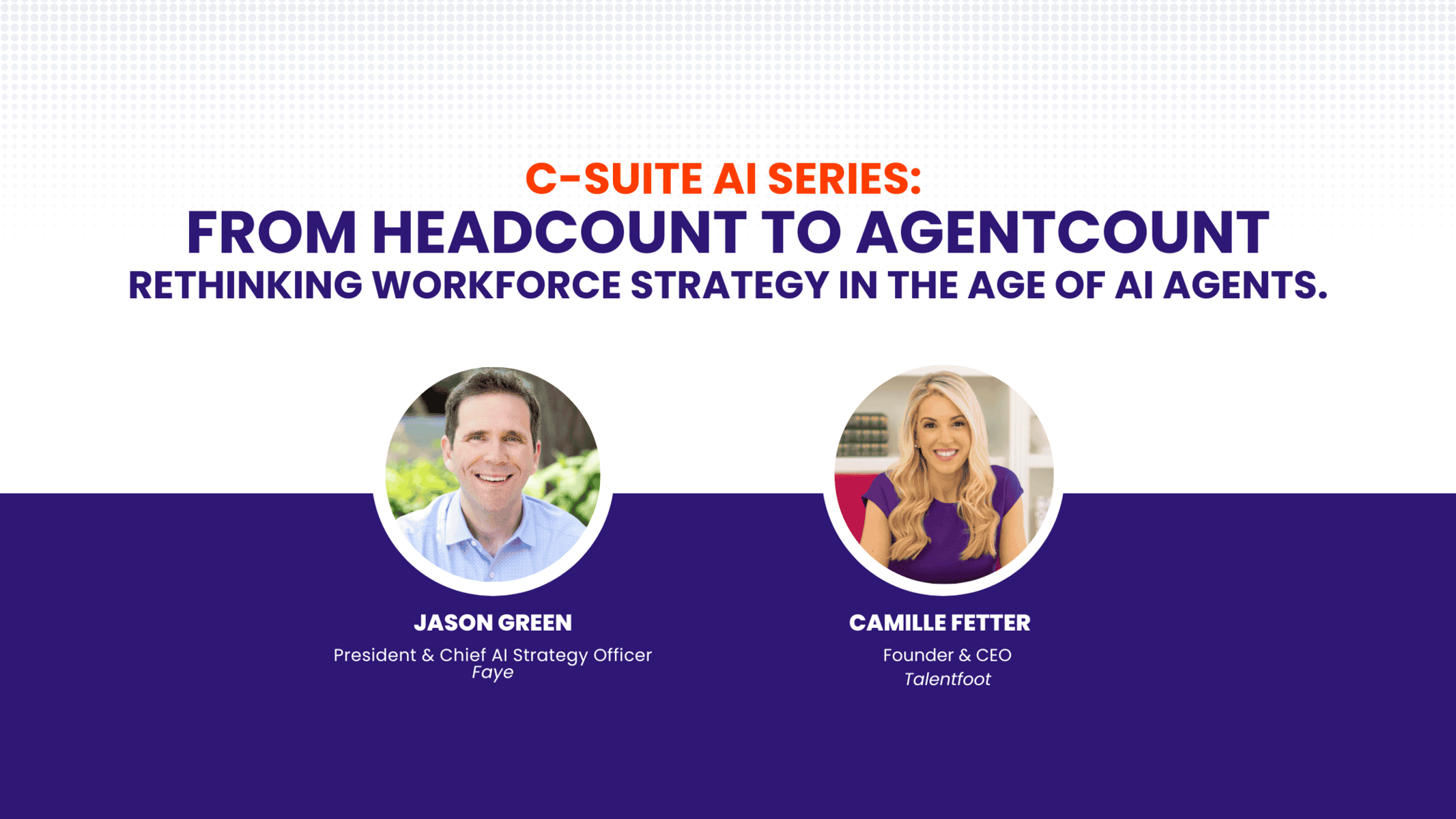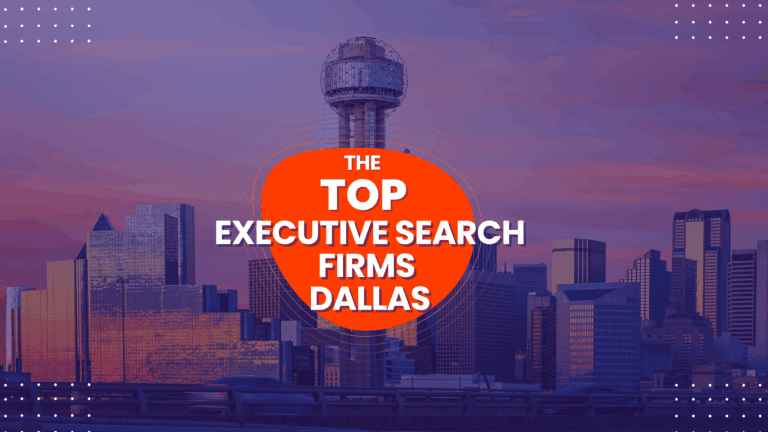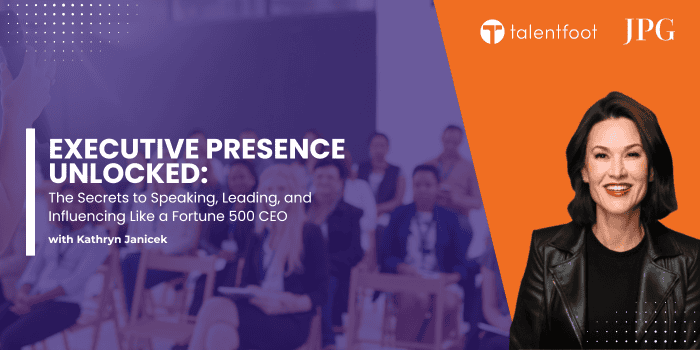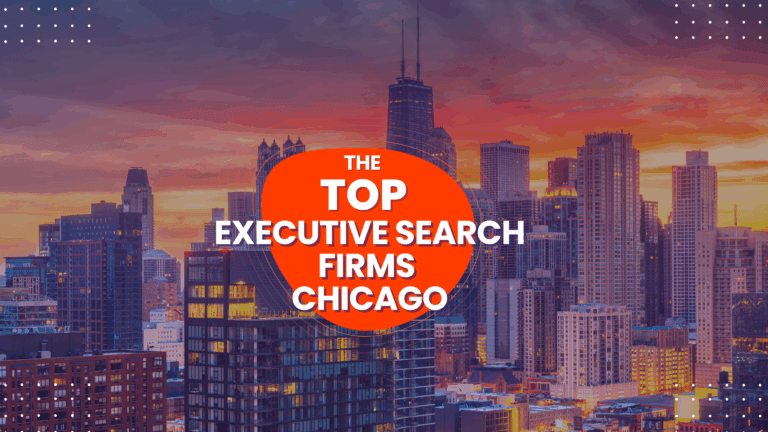Table of Contents
- Executive Summary & Key Takeaways
- Why AI Workforce Strategy Demands Your Attention Today
- The Rise of AI Agents in the Modern Workforce
- The Real Cost of Delaying Your AI Workforce Strategy
- Redesigning Your Org Chart for Humans and Agents
- How to Build a Future-Ready AI Workforce Strategy
- Why C-Suite Leaders Must Get Hands-On with AI
- Strategic Questions to Refine Your AI Workforce Planning
- Final Word: AI Workforce Strategy Begins at the Top
Executive Summary & Key Takeaways
In Talentfoot’s exclusive C-suite webinar, From Headcount to Agentcount, Talentfoot Founder & CEO Camille Fetter and Jason Green, President & Chief AI Strategy Officer at Faye, delivered a wake-up call to today’s business leaders: AI agents are no longer a future concept. They are already transforming how organizations operate, scale, and grow. This shift requires immediate attention from executive leadership and a bold rethinking of workforce strategy.
The conversation centered around one central message: AI workforce strategy is now a leadership imperative. The organizations that act now will unlock efficiencies, create new revenue streams, and attract future-ready talent. Those who delay risk becoming the next Blockbuster or Kodak.
Key Takeaways:
- AI agents are reshaping work today
These systems are capable of reasoning, creating, and executing autonomously. They reduce time-to-value, amplify productivity, and elevate team performance across departments. - A “wait and see” approach is the most expensive decision you can make
With new models launching monthly, inaction creates vulnerability. Leaders must start experimenting now to stay ahead of inevitable industry disruption. - The org chart must evolve
Executives should audit roles and functions to identify where agents can complement or replace traditional responsibilities, and begin designing a hybrid human-agent structure. - AI is not just IT’s responsibility—it is a C-suite competency
Understanding core tools, models, and prompting techniques is now essential to asking the right strategic questions and leading AI transformation from the front. - Small wins are meaningful
Unlike traditional tech initiatives, AI can deliver ROI in stages. Reducing a process from 500 to 200 hours is still a strategic victory. - Prompt engineering is the new executive language
Learning how to interact with LLMs and agent builders enables leaders to move from abstract strategy to applied innovation.
Watch The Webinar
Why AI Workforce Strategy Demands Your Attention Today
Boards and investors are no longer tolerating uncertainty around AI. Executive replacements are rising in response to a lack of urgency, clarity, or capability in the face of accelerating AI adoption. Leaders who can clearly articulate their AI posture and demonstrate experimentation are more likely to be retained—and promoted.
“Boards are asking executives how they plan to drive efficiency with AI. If they stumble over that question, the clock starts ticking.” —Camille Fetter
The Rise of AI Agents in the Modern Workforce
AI agents are digital teammates that can operate with autonomy and context, providing support in customer service, operations, finance, marketing, and more. They reason, create, and execute in ways that mimic human capabilities—at a fraction of the cost and time.
“If knowledge and creativity become free—or nearly free—what does that mean for the workforce?” —Jason Green
The organizations winning today are embedding these agents directly into business processes to reduce friction, increase throughput, and expand market opportunity.
The Real Cost of Delaying Your AI Workforce Strategy
Executives who delay experimentation are often under the false impression that they’ll have time to catch up later. In reality, new models are released monthly, with major performance leaps that can dramatically shift what’s possible.
“You don’t have the luxury of waiting. This is happening now. Your industry may not flip tomorrow, but if it flips in six months and you’re not ready, it’s too late.” —Jason Green
Redesigning Your Org Chart for Humans and Agents
Many organizations continue to design org charts as if only humans will do the work. But forward-thinking leaders are already asking: where can agents take on defined responsibilities?
“You might find that a single agent can take on one task shared across seven departments—something no human role could justify, but AI can.” —Jason Green
Rethinking structure isn’t just about efficiency—it’s about unlocking entirely new ways of working.
How to Build a Future-Ready AI Workforce Strategy
Jason outlined a phased framework to help leaders get started:
-
Align leadership around AI beliefs and organizational values
-
Define your AI posture and communicate it internally and externally
-
Identify pilot use cases with low-lift and high-impact potential
-
Run proof-of-concept experiments using safe, sandboxed data
-
Evaluate scalability and iterate based on results
-
Expand across departments and track value creation
-
Revisit your business model to assess new markets or products enabled by AI
Camille shared the story of a CIO who was tasked with saving 500,000 human hours through AI by year-end. That type of measurable objective forces organizations to act,not just ideate.
Why C-Suite Leaders Must Get Hands-On with AI
Leadership today means knowing what’s possible. Jason and Camille stressed that C-suite leaders must stop delegating their understanding of AI to IT or innovation teams. The insights gained from using tools firsthand are irreplaceable.
“You cannot lead conversations about where AI fits in your org if you don’t understand the tools yourself.” —Camille Fetter
Recommended tools for executives to explore include:
-
GPT-4, Claude, Perplexity (LLMs)
-
RunwayML (video)
-
HeyGen (AI avatars)
-
Eleven Labs (voice cloning)
-
Midjourney/DALL·E (image generation)
Strategic Questions to Refine Your AI Workforce Planning
Before your next board presentation or strategic planning session, ask:
-
What is our organization’s AI posture? Is it clearly articulated?
-
Who is accountable for AI transformation and agent integration?
-
Have we experimented with at least one agent-based workflow?
-
What roles could be partially or fully supported by agents?
-
Are we training our team to collaborate with agents effectively?
-
Do we understand enough about prompt engineering to lead?
Final Word: AI Workforce Strategy Begins at the Top
This is not a technology story—it is a leadership one.
“The market doesn’t care how long your team has done things the old way. It cares how fast you can adapt.” —Jason Green
Companies that succeed in the age of AI will not only implement tools. They will reimagine processes, roles, and models with agents as a core part of the equation. That shift begins with C-suite leaders who are willing to explore the unfamiliar and lead by example.




